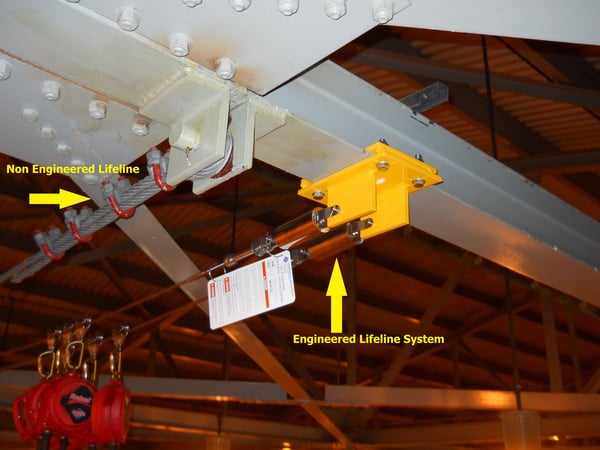Cable Lifeline Fall Protection Systems
Most folks think lifelines when it comes to fall protection, but if you quiz them about how these systems work or when they are good fits for an application, they come up short. So what is a cable-based fall protection system, and what are the pros and cons of lifeline systems?
Cable fall protection systems take many names, including rat lines, HLL’s, and horizontal lifelines just to name a few. In their simplest form, cable fall protection systems consist of wire rope secured by a series of terminal and intermediate anchor points. By connecting a body harness and lanyard to a shuttle traveling the length of the line, a worker can safely move along a horizontal (or vertical) plane. Cable systems are deceptively simple in design, but done properly, they are actually highly engineered fall protection systems.
In a previous post titled “Is My Horizontal Lifeline Safe?”, we shared pictures of some home-made rat lines we have encountered in the field. Lifelines made from combinations of wire rope, wire rope clips, and turnbuckles may look safe, but these home-made solutions share little in common with the engineered lifelines we design and install at DFP.
OSHA regulations say nothing about the materials required to build a lifeline, but do include specific language describing system performance in the event of a fall:
1926.502(d)(8)
Horizontal lifelines shall be designed, installed, and used, under the supervision of a qualified person, as part of a complete personal fall arrest system, which maintains a safety factor of at least two.
And although the remaining language in this section of the OSHA regulations isn’t specific to horizontal lifelines, it is instructive:
Personal Fall Arrest Systems
1926.502(d)(16)
Personal fall arrest systems, when stopping a fall, shall:
1926.502(d)(16)(ii)
limit maximum arresting force on an employee to 1,800 pounds (8 kN) when used with a body harness;
1926.502(d)(16)(iii)
be rigged such that an employee can neither free fall more than 6 feet (1.8 m), nor contact any lower level;
1926.502(d)(16)(iv)
bring an employee to a complete stop and limit maximum deceleration distance an employee travels to 3.5 feet (1.07 m); and,
1926.502(d)(16)(v)
have sufficient strength to withstand twice the potential impact energy of an employee free falling a distance of 6 feet (1.8 m), or the free fall distance permitted by the system, whichever is less.
If you glean nothing else from the discussion above, it should be obvious that without an engineering background and fall protection training, the individual charged with designing and installing your home-made solution will not meet OSHA standards. Now that we have a better definition of the system, let’s turn to the advantages and disadvantages of cabled-based systems.
Advantages of Cable Fall Protection Systems
- Cable systems can span larger coverage areas in a more cost-effective manner than rigid rail fall protection systems or guardrail
- Impart smaller, lighter footprints on elevated work spaces than fabricated rail-based fall protection systems
- Reduced fabrication and installation lead times
- Easily accommodate bends and the absence of pre-existing anchor points required to suspend rigid solutions
Disadvantages of Cabled Based Fall Protection
- Higher deflection rates than rigid rail fall protection systems
- Require more fall clearance distance than rigid systems
- Overhead gallows style systems will require more substantial foundations than corresponding rail based systems
If you are wondering which system (cable or rigid rail) is best, prepare for an ambiguous answer. Cable fall protection systems offer many benefits, but they aren’t suitable for every application. By working with a qualified fall protection company, you can make an informed system selection on the engineered fall protection that best meets your application needs and budget. To learn more about cable fall protection systems, contact the safety experts at Diversified Fall Protection for further assistance.
Schedule an assessment with Diversified Fall Protection
Contact Us to request a fall safety review

b-1.jpg?width=1368&height=1340&name=Rail%20(175)b-1.jpg)


